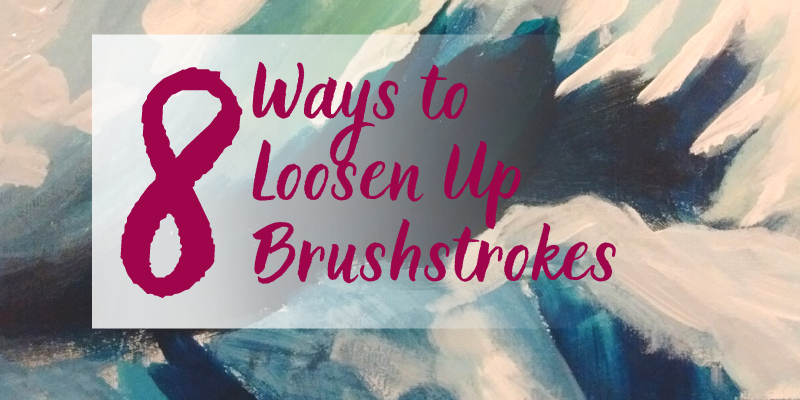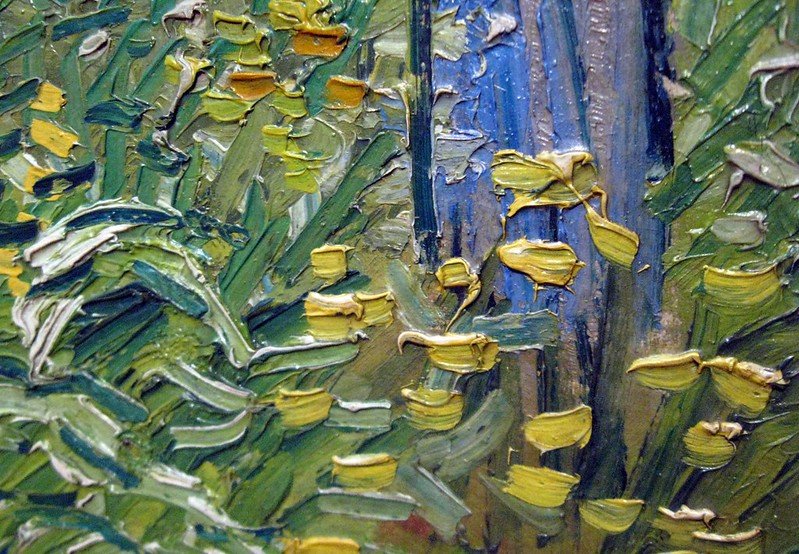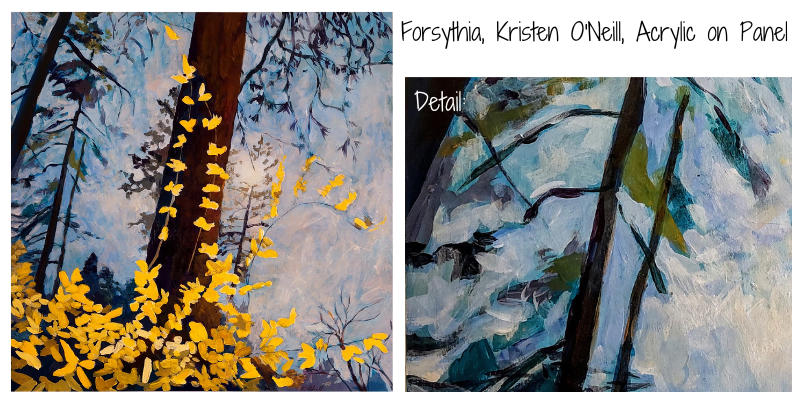Loosen Up Brushstrokes
A lot of painters struggle with ways to loosen up brushstrokes to create the feeling they want in their paintings. The Impressionists helped us fall in love with brushstrokes. And, for over a hundred years, artists have explored celebrating the fact that paint is made out of paint by allowing the physicality of it to be important. (Instead of blending and hiding every stroke possible like in the Renaissance.) This lesson is designed to give you a few different approaches to applying paint, what and how to paint, and supplies to use. Enjoy your journey to loosening up the brushwork and have bold and painterly work. Expressive brushstrokes here we come!
1. Position of Your Body
Stand up at your easel. This simple tip gets you out of a hunched over position and gives you enough room to move around painting. The physicality of painting can be easy to think of just on the surface, but there is the physicality of applying the paint. When I get to be big and bold on a composition, I put on my favorite energizing music and go for it! If you are physically unable to stand, you can still apply this general idea. Make yourself enough space to move about uncramped. Have an area where you can back up from the painting to see how things are going from farther away.
2. Types of Brushes
Try long-handled brushes. Once we aren’t choked up on our brush handles, we have more room to gesture.
Think about the stiffness of the bristle for oil and acrylic. If the bristle isn’t stiff enough it just bends when he paint is applied – great for blending, but if we are looking to create a surface of strokes, it may not be the best tool.
Size of the brush. Using a detail 00 size brush is going to have you painting a hundreds of little strokes to fill an area. Can you go wide? Wider? Wider than that? The Liquitex paddle brushes were a lot of fun for me while working on larger (40″x 40″) series of crashing waves. The complete lack of a handle on the Freestyle paddle brushes allowed me to gesture with my hand right next to the canvas, and the long handle was fun for the big splashy waves.
3. Plan Your Composition First
If we know were we are going, we can make our decisions with more confidence. Do you turn right or left at the next block? If we have a map, we aren’t fumbling as we approach. If we know where our lines need to head, we can paint them without feeling hesitant. Hesitant brushstrokes result in us feeling like we need to go back over them again. Pretty soon, we’re fussing!
4. Plan Your Color Palette
When we plan ahead, we know that we will be able to create the color harmony we will need. Then we don’t have to rush in at the 11th hour of the painting, trying to sneak little bits of paint around to attempt to make a new color look like it belongs. Figuring out the colors ahead of time also helps us know that we can achieve the value range we are looking for in the painting.
5. Thicken Up Your Paint
The common term in painting about this is “Impasto.” That is when paint is applied thickly to the surface. Do you have enough paint on your brush? Is it creating the texture that you are looking for as you apply it? Do you need to add a medium? For oil paint you can add cold wax, and for acrylic there are a lot of mediums formulated to build up the structure of the paint.
6. Brushwork – Decisive and Spontaneous Feeling
At what speed are you applying your paint? At what force? Timid strokes read that way.
Do you need to do some gesture warm-up painting sketches? Sometimes just warming up is a great way to loosen up brushstrokes.
Are you listening to music that helps this feeling resonate through you as you work? Fast beats, or slow and steady? I know I can’t listen to fast music and drive the speed limit. So why would painting be different?
You can plan out your brushstrokes as long as you want, but try to really go for it when you apply them.
Have you tried Wet-on-Wet (fancy name is “Alla Prima”)? This is where you work wet paint on top of or into other wet paint on the surface. Watercolorists often live in this space. However, acrylic artists can have trouble getting this done quickly enough before the paint dries. I often use slow-drying acrylics to that I can still work wet-on-wet.
7. Details – Be Selective
Our brains are amazing! They can put together information from the slightest amount of data. Sometimes jumping to conclusions. What is the minimum you need to imply what you are trying to show the viewer? Does adding more improve the painting, or just bog down the viewer? Brushstrokes are how we are showing all the details, how we show everything really. Are the details the right scale to the rest of the work to be included? Our eyes see more of a scene than it makes sense to paint.
8. Less Surface Absorption
Let me tell you, I learned this one the hard way. I had an idea to paint this beautiful but errie day in the park, during the Covid lockdown. I went home, and set up the reference photo on my computer. I had a wooden panel, so I decided to use that (can’t go to the store!) and started to paint. And paint. And paint. I put on Downton Abby on Netflix. I watched the ENTIRE series, just trying to keep the paint on the painting instead of being absorbed. I had not primed the panel in advance and that wood just kept soaking up my paint. The result is a very feathered feeling of paint application on the surface. But, I could have been okay with only needing to do a few layers, and not seasons 1, 2 and 3 on just the sky.
Painting with acrylic on watercolor paper can give you the same issue. The paper is a made to absorb a lot of water, and it tries to do just that! I recommend Canson paper for oil and acrylic if you are looking to paint on paper. I painted my entire Oregon Coast Trail series on it. Worked great, and it didn’t feel to “precious” to use and try out things on. It has a tooth to it, but not the absorption of primed canvas.
Products I Use and Recommend
I get asked a lot about specific supplies I use and enjoy. I put together this list to help you. They are affiliated links, so buying this way does help me keep putting out this content free of charge, with no extra cost to you. I also love it when people support their LOCAL art store! Drop a comment of your favorite local art store below!
Canson Paper for Oil & Acrylic – an awesome paper that holds up to oil & acrylic, is archival, and affordable!
Liquitex 3″ Freestyle Brush – so much fun! Remember to wash in cold water to preserve the brush as long as possible.
Gamblin Cold Wax Medium (for Oil Painters) – hello impasto!
Slow-Drying Acrylic – Golden OPEN – love these. Great pigment load and quality. Slow-drying – can keep wet as long as you need if your studio is cold. As a former oil painting snob, I would say if you are going from oil to acrylic – these are for you. Or, if you love acrylic, and want them to allow wet-on-wet techniques.





